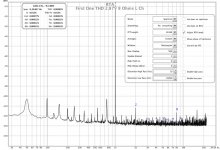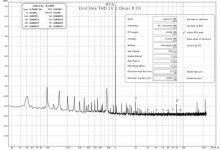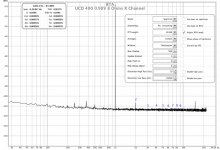It's a promising start  .
.
You might need to fine tune the tonal balance. I'm not surprised the lightness of a piano on the side is less pronounced. Is it there with headphones? This filter has settings that should make side sounds a bit more weighted. At least compared to the phantom center. Most easily heard in side panned back ground vocals where they turn into actual people singing instead of "radio like" background voices. (depending on where the balance was set before)
You might need to fine tune the tonal balance. I'm not surprised the lightness of a piano on the side is less pronounced. Is it there with headphones? This filter has settings that should make side sounds a bit more weighted. At least compared to the phantom center. Most easily heard in side panned back ground vocals where they turn into actual people singing instead of "radio like" background voices. (depending on where the balance was set before)
It's a promising start.
You might need to fine tune the tonal balance. I'm not surprised the lightness of a piano on the side is less pronounced. Is it there with headphones? This filter has settings that should make side sounds a bit more weighted. At least compared to the phantom center. Most easily heard in side panned back ground vocals where they turn into actual people singing instead of "radio like" background voices. (depending on where the balance was set before)
Never use headphones now, so I wouldn't know. Headphones has never worked for me, because of the weird perspective. I do listen a lot to orchestral music and I don't like to have a complete symphony orchestra inside my head.
I do, however, appreciate the tonal balance achieved with headphones. I had many years ago Stax headphones with dedicated amplifier (SR III with SRA 12, with Stax electrostatic PU as well) and they sounded very good, but did not involve me in the music the way speakers do.
I am looking foreward to investigate this interesting filter in more depth and with a lot of other music, but for now, it is a winner.
Thanks for sharing Fluid and wesayso
Good to hear it is working for you so far, I find that music with vocals has the most pronounced effect, also by using the pan control in FabFilter you can change the balance between the mid and sides to see which is your preference up to a dB or so can make quite a difference.
So far we have arrays 3 anything else nil, I was hoping to get some more feedback from other systems but perhaps this thread is not the best vehicle for that.
Good to know a positive effect is not just limited to me and wesayso though
...I was hoping to get some more feedback from other systems but perhaps this thread is not the best vehicle for that...
I'm lurking, and getting my feet wet by downloading JRiver Media Center, Audacity and Foobar. Trying to get to know the programs and watch some youtube tutorials. The problem I have is my "supercomputer" is quite bulky. I've been eyeing a mini or micro-ATX design around a horizontal box, much like your NUC. But yes a new dedicated thread would be awesome. Some of the effects and sounds that are possible are really exciting from what I've seen and heard. When I was first into building speakers many years ago, I purchased an Ensoniq ASR-10 sampling keyboard. I was all about the 16-bit sampling and the multi-voice effects. I want to get back into it. Definately a bucketlist item, for me personally, to take advantage of new 24-bit technology! I think back then, the Pentium processor was not even in existence!
Cheers!
Last edited:
We did have perceval trying... with his OB setup.
And I'm not done yet!
I didn't throw in the towel. I'm doing other stuff in parallel and will shortly get back into this.
I've added the M/S preset to my listening for the last week or so, under Audacity this time. Trying to get accustomed to it. Later, I'll revert to my setup without the M/S preset and see how I feel about the whole thing.
Be sure to have the mid/side EQ before any speaker correction EQ or otherwise in your chain (like FIR)...
Well, here's the chain:
Computer, Audacity, FabFilter preset, sent via usb to miniDSP HD, XO and EQ in miniDSP HD, miniDSP HD D-A out to 4 amp channels.
No FIR, no convolution here.
Last edited:
I did some REW testing of my amplifiers to verify the Distortion performance. I wanted to make sure that the bias setting of the First One 1.4M was correct as someone else had seen quite a change in distortion due to biasing.
It is tricky to do because the VAS bias changes with temperature and getting it to be stable takes time. This also means that the amp does need some time to warm up before it sounds right.
I saw no discernible change at 1V to 2.83V with bias between 18ma and 29ma so I set it at 18 which is the standard, overall bias is 280ma which is why it runs warm. The left and right channels give different results and the test setup was not ideal from a noise perspective so I will redo it later on for more conclusive results. Distortion is pretty low and only rose to 0.05% at 25V on an 8 ohm load.
Here is the best result I got from the First One which is really very low at 0.0008% at just over 1W. Given that the soundcard itself shows 0.0005% on loopback through the analyser, meaning only 0.0003% was due to the amp. This must have been a sweet spot or getting the grounding right because no other readings were nearly as good.
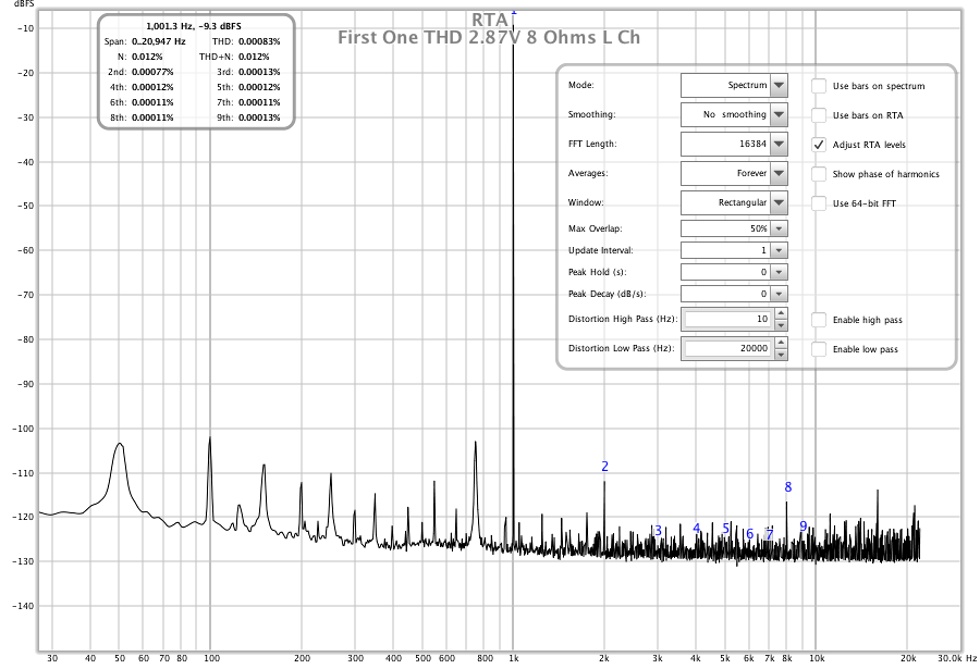
I tested the UCD400 at 1V output, and overall it looks very good. Only the tiniest bit of 2nd harmonic and the differential input seems to have done a better job of suppressing power supply noise with the noise floor being flatter below 1K, either that or the Hypex power supplies are considerably less noisy. I might test a differential input for the First One later to see if that evens it out. The spike at 16K appears in most of the measurements not quite sure where that is coming from.

The First One at 1V measures about the same but with lower noise.
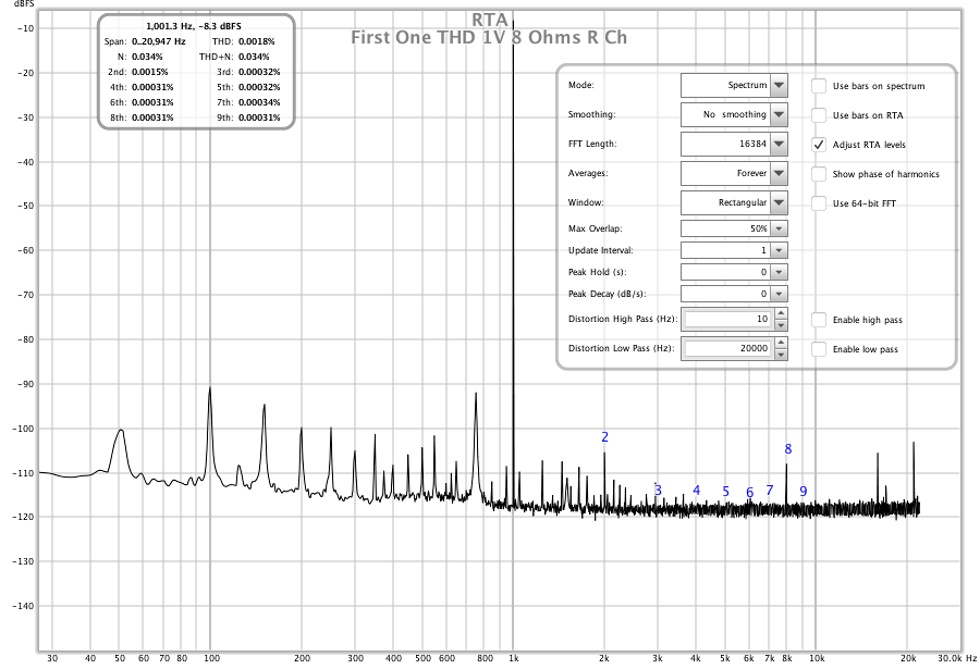
My Chinese power resistors performed brilliantly hardly even getting hot in the short time I used them. The same can't be said for the 3W pot I bought to use in an attenuator circuit. I didn't do my power calculations properly and I let the magic smoke out of it That was annoying because I spent a lot of time mounting it to a board and marking the amount of resistance. I had some other power resistors so I was able to use a combination of them to pad the output of the amp down to 1V without blowing them up
That was annoying because I spent a lot of time mounting it to a board and marking the amount of resistance. I had some other power resistors so I was able to use a combination of them to pad the output of the amp down to 1V without blowing them up 
It is tricky to do because the VAS bias changes with temperature and getting it to be stable takes time. This also means that the amp does need some time to warm up before it sounds right.
I saw no discernible change at 1V to 2.83V with bias between 18ma and 29ma so I set it at 18 which is the standard, overall bias is 280ma which is why it runs warm. The left and right channels give different results and the test setup was not ideal from a noise perspective so I will redo it later on for more conclusive results. Distortion is pretty low and only rose to 0.05% at 25V on an 8 ohm load.
Here is the best result I got from the First One which is really very low at 0.0008% at just over 1W. Given that the soundcard itself shows 0.0005% on loopback through the analyser, meaning only 0.0003% was due to the amp. This must have been a sweet spot or getting the grounding right because no other readings were nearly as good.
I tested the UCD400 at 1V output, and overall it looks very good. Only the tiniest bit of 2nd harmonic and the differential input seems to have done a better job of suppressing power supply noise with the noise floor being flatter below 1K, either that or the Hypex power supplies are considerably less noisy. I might test a differential input for the First One later to see if that evens it out. The spike at 16K appears in most of the measurements not quite sure where that is coming from.
The First One at 1V measures about the same but with lower noise.
My Chinese power resistors performed brilliantly hardly even getting hot in the short time I used them. The same can't be said for the 3W pot I bought to use in an attenuator circuit. I didn't do my power calculations properly and I let the magic smoke out of it
Attachments
Edit to post above First One at 1V has peakier noise not lower.
This is where the measurements can't be used solely to determine perceived sound quality.
The UcD looks better but it does not sound as good. I do prefer the First One, the bass is better and overall the sound is smoother, both are very good but there is just something about the UcD that I don't like as much, this has been the same on every speaker I have tried it with.
I was having a nice time listening to the First One when the left channel disappeared. There is a DC protection board on the output that turns off the power supply when tripped. This is what happened, I reset it and all was good again for a while before it tripped again.
I need to determine if it is nuisance tripping or if I have some DC offset coming from the DAC, it didn't trip while I was using the Focusrite to test it so I suspect the LKS DAC for now.
Bit of a bummer as for now DC has stopped play
This is where the measurements can't be used solely to determine perceived sound quality.
The UcD looks better but it does not sound as good. I do prefer the First One, the bass is better and overall the sound is smoother, both are very good but there is just something about the UcD that I don't like as much, this has been the same on every speaker I have tried it with.
I was having a nice time listening to the First One when the left channel disappeared. There is a DC protection board on the output that turns off the power supply when tripped. This is what happened, I reset it and all was good again for a while before it tripped again.
I need to determine if it is nuisance tripping or if I have some DC offset coming from the DAC, it didn't trip while I was using the Focusrite to test it so I suspect the LKS DAC for now.
Bit of a bummer as for now DC has stopped play
Even if the First one that is preferred subjectively, this might not mean the UCD could still be the more "honest to the input" amplifier. 
Can you run the same test at a lower frequency? To see if there are differences like that in that bass department? What if the higher second order peaks are responsible for the sweeter sound .
.
Can you run the same test at a lower frequency? To see if there are differences like that in that bass department? What if the higher second order peaks are responsible for the sweeter sound
You could view it that way but how do you actually verify it? To me that is similar reasoning to make the frequency response "flat" because that will make it true to the recording. I think we would both agree that with speakers subjectively that does not give the best presentation. I like the UcD but there is something that is slightly irritating when compared to a good A/B amp, so for me it isn't a long term solution.
Nelson Pass puts a lot of effort into getting the balance of the distortion "right" as the amount of 2nd to 3rd harmonic is important. Same sort of reason that Tube amps are popular with some.
I have started to move away from trying to make the most "accurate" system as that does not necessarily lead me towards enjoyment. That doesn't mean I don't want to make it better, but I am looking to find what it is in the measurements that makes it sound better to me.
The test can be run at whatever frequency the generator is set at. Most THD readings are done at 1K so it allows comparison to similar measurements. I don't have the time to do more testing now and probably won't for quite a while.
See if you can find someone who has a UcD amp to try out, maybe you will like it more than your Pioneer but if it is any kind of reasonable Class A/B amp then I doubt it. I am very interested to try an Ncore to see if the same sort of thing affects those too.
Nelson Pass puts a lot of effort into getting the balance of the distortion "right" as the amount of 2nd to 3rd harmonic is important. Same sort of reason that Tube amps are popular with some.
I have started to move away from trying to make the most "accurate" system as that does not necessarily lead me towards enjoyment. That doesn't mean I don't want to make it better, but I am looking to find what it is in the measurements that makes it sound better to me.
The test can be run at whatever frequency the generator is set at. Most THD readings are done at 1K so it allows comparison to similar measurements. I don't have the time to do more testing now and probably won't for quite a while.
See if you can find someone who has a UcD amp to try out, maybe you will like it more than your Pioneer but if it is any kind of reasonable Class A/B amp then I doubt it. I am very interested to try an Ncore to see if the same sort of thing affects those too.
Last edited:
Well, it isn't that I would say to prefer the UcD over the first one, in fact, quite the contrary.
We don't always like the cleanest sound. I'm not afraid to admit I go for satisfaction myself, even over accuracy. However it is learning from it that makes me curious what the differences are, so we can use it.
My pioneer does have a sweet sound. At least in combination with the arrays and my previous speakers. It's a high bias class A/B. I do not expect to win anything with replacing it.
But that still might mean the UCD is the more honest amplifier. Though some parts are hard to measure. Like the buffer setting I had set wrong. A huge difference in perception for me, yet the measurements still looked fine. I suspect a flow problem in the audio stream might still measure fine, but be something that turns us off.
Still not sure how to unravel that part of the audio stream. It's like jitter, hard to find yet might be pretty important in perception. I'd rather experiment with full class A as a move from my A/B amp than any of the newer topologies. Even though they (the newer ones) measure fine.
See the distortion discussion in this thread: Who makes the lowest distortion speaker drivers
I do believe we, as listeners might like/prefer a bit of second order at lower frequencies. It might fatten up the sound in a pleasant way. Just as some drivers that are described as having more detail might actually have more third order distortion up high.
So are we really looking for perfection? Or the sweetest combination that fits our taste.
I fall in that last group. However strange that might sound with the graph's like I have shown.
My ambient experiments show it though, as I do adjust to taste. Based on what I like to hear in a (my) room. I'm still messing with what goes in, so not exactly a purity concept. Just catering to my specific taste.
We don't always like the cleanest sound. I'm not afraid to admit I go for satisfaction myself, even over accuracy. However it is learning from it that makes me curious what the differences are, so we can use it.
My pioneer does have a sweet sound. At least in combination with the arrays and my previous speakers. It's a high bias class A/B. I do not expect to win anything with replacing it.
But that still might mean the UCD is the more honest amplifier. Though some parts are hard to measure. Like the buffer setting I had set wrong. A huge difference in perception for me, yet the measurements still looked fine. I suspect a flow problem in the audio stream might still measure fine, but be something that turns us off.
Still not sure how to unravel that part of the audio stream. It's like jitter, hard to find yet might be pretty important in perception. I'd rather experiment with full class A as a move from my A/B amp than any of the newer topologies. Even though they (the newer ones) measure fine.
See the distortion discussion in this thread: Who makes the lowest distortion speaker drivers
I do believe we, as listeners might like/prefer a bit of second order at lower frequencies. It might fatten up the sound in a pleasant way. Just as some drivers that are described as having more detail might actually have more third order distortion up high.
So are we really looking for perfection? Or the sweetest combination that fits our taste.
I fall in that last group. However strange that might sound with the graph's like I have shown.
My ambient experiments show it though, as I do adjust to taste. Based on what I like to hear in a (my) room. I'm still messing with what goes in, so not exactly a purity concept. Just catering to my specific taste.
Which measurements are the right ones represents the key to quantifying what is important.
As far as amplifiers go I don't think THD is the best way to judge them at least when the distortion is below a certain level. My measurements were to confirm the best bias setting and then how they compared to each other.
When you look at the previous RTA shots the distortion is 90 to 100dB below the fundamental, that is going to be swamped by the speaker itself many times over.
Output impedance, damping factor and transient response are very important in terms of how the amplifier controls the speaker. These are tricker to measure so there is often lots of frequency response and THD graphs instead
As far as amplifiers go I don't think THD is the best way to judge them at least when the distortion is below a certain level. My measurements were to confirm the best bias setting and then how they compared to each other.
When you look at the previous RTA shots the distortion is 90 to 100dB below the fundamental, that is going to be swamped by the speaker itself many times over.
Output impedance, damping factor and transient response are very important in terms of how the amplifier controls the speaker. These are tricker to measure so there is often lots of frequency response and THD graphs instead
True, but every 1 kHz note will excite some 2 kHz movement in a driver used with the amplifier. And drivers are not as clean as the amp and will build upon whatever it is fed.
It's like measuring a lot of small pieces to figure out the grand total of a larger distance. The small flaws do add up. I'll agree that these are low distortion figures, but are they just as low at 40 Hz?
The overall result will be a complicated mixture of all components that make up the chain. If you hear a difference, there will be a difference in the measurement. These graphs already show one difference. Everything matters. And nothing at all .
.
It's like measuring a lot of small pieces to figure out the grand total of a larger distance. The small flaws do add up. I'll agree that these are low distortion figures, but are they just as low at 40 Hz?
The overall result will be a complicated mixture of all components that make up the chain. If you hear a difference, there will be a difference in the measurement. These graphs already show one difference. Everything matters. And nothing at all
Last edited:
1K is usually where the distortion measures lowest which is why most manufacturers choose it. I do not know what it is like at 40 Hz as I haven't checked.
LC measured the First One at 100Hz (0.003) 1K (0.001) and 10K (0.004) which is the typical smiley face distortion curve.
One thing to look at in the graphs above is the N and THD+N figures. See how they are both the same? At 1V to 1 watt it is noise and the distortion doesn't even move the needle due to relative weights. Higher Powers will show the distortion contribution more but even then noise is still the major factor. Even though they measure the same the distortion will be heard as it is a peak and the noise is all the other frequencies in the FFT bin averaged together.
The measurement of the amps is different no surprise there. The difference is most pronounced below 1K due to power supply interference. The amps use different topologies so it is hard to know if some of that is due to reduced common mode interference in the differential input or reduced PSRR in one amp.
The UcD sounds very clean and clinical in the bass the First One more involving and exciting. That's the part that matches the RTA graph.
If I looked with my eyes I would choose the clean one but my ears prefer the lumpy one.
The First One added back something that seemed missing after all the processing and smoothed out some of what was sounding slightly harsh in the mid to high frequencies on some tracks and genres.
This is another one of those situations where well recorded mixed and mastered music sounds more similar with both amps, slightly sweeter in the mids and HF. It's the other stuff that benefits the most, given that I tend to prefer the other stuff from a musical perspective it's a welcome addition.
Seems to raise more questions than provide answers though.
LC measured the First One at 100Hz (0.003) 1K (0.001) and 10K (0.004) which is the typical smiley face distortion curve.
One thing to look at in the graphs above is the N and THD+N figures. See how they are both the same? At 1V to 1 watt it is noise and the distortion doesn't even move the needle due to relative weights. Higher Powers will show the distortion contribution more but even then noise is still the major factor. Even though they measure the same the distortion will be heard as it is a peak and the noise is all the other frequencies in the FFT bin averaged together.
The measurement of the amps is different no surprise there. The difference is most pronounced below 1K due to power supply interference. The amps use different topologies so it is hard to know if some of that is due to reduced common mode interference in the differential input or reduced PSRR in one amp.
The UcD sounds very clean and clinical in the bass the First One more involving and exciting. That's the part that matches the RTA graph.
If I looked with my eyes I would choose the clean one but my ears prefer the lumpy one.
The First One added back something that seemed missing after all the processing and smoothed out some of what was sounding slightly harsh in the mid to high frequencies on some tracks and genres.
This is another one of those situations where well recorded mixed and mastered music sounds more similar with both amps, slightly sweeter in the mids and HF. It's the other stuff that benefits the most, given that I tend to prefer the other stuff from a musical perspective it's a welcome addition.
Seems to raise more questions than provide answers though.
Thanks interesting amp stuff fluid, in we know common interconnection between units should mean a lot often pointed out by creator of Jensen-trasformers/That-IC and B. Putzey, then what about rerun UCD400 cabled non differential so input condition was same for both tests and see if it change anything in both objective and subjective direction.
- Home
- Loudspeakers
- Full Range
- Full Range TC9 Line Array CNC Cabinet
